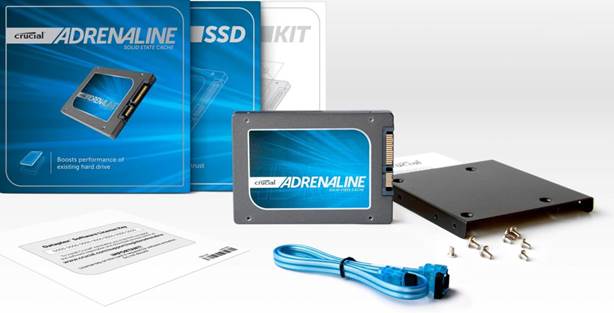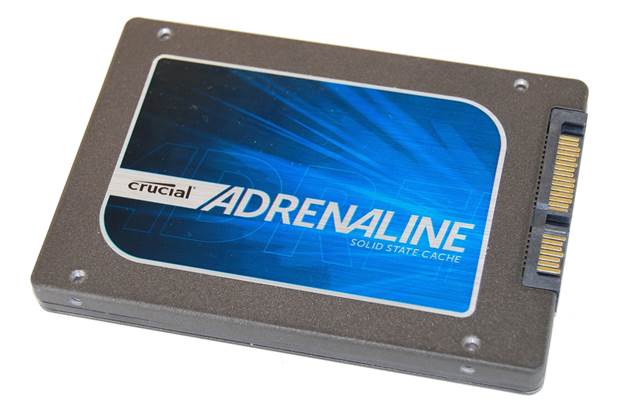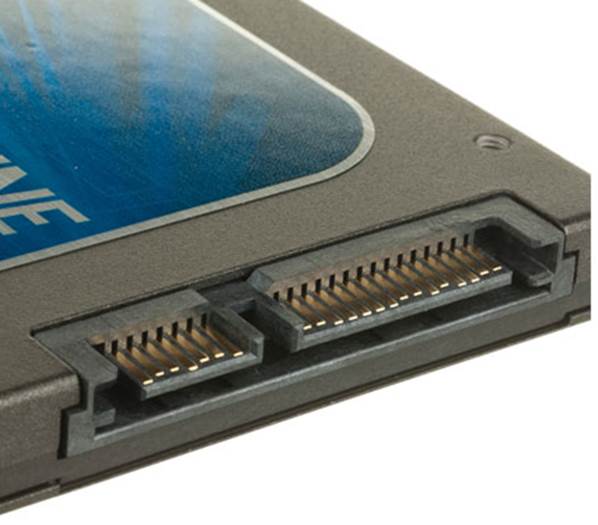Crucial has given serious thought to the
Adrenaline cache drive and delivers a package that looks the absolute business.
The outer sleeve contains two inner packs, with one containing the SSD and the
other holding the kit. We know that because they're labelled 'SSD' and 'Kit'.

Crucial
Adrenaline 50GB
The kit consists of a drive bay adapter,
some mounting screws and a SA TA cable with a right-angled connector at one
end.
The SSD is a regular Crucial m4 drive that
measures 9mm in thickness. Remove the four screws that hold the case together
and you can pull out a 3mm plastic shim that slims the drive down to 6mm. That
is irrelevant to PC builders, but it could be very handy if you're upgrading a
laptop, and that shows the heritage of this drive, as it's a regular Crucial m4
SSD. When you remove the SSD from its foam tray, it reveals a Dataplex licence
key. This is exactly the same software that you get with the Corsair
Accelerator, so you have to go through the same process to download and install
it. This task is made easier by having the licence key on a card, rather than
having to read it from the tiny label on the Corsair drive.
When the SSD is open, the first sight is
the back of the PCB, which is a curious thing, because it's entirely blank and
unused. Pop out the board and you'll find all the components are on one side,
which consists of the Marvell controller chip, the cache chip and the eight
flash chips.

When
the SSD is open, the first sight is the back of the PCB, which is a curious
thing, because it's entirely blank and unused.
The board is a full length PCB, so Crucial
clearly hasn't redesigned this desktop/laptop drive for caching duties but has
simply repackaged the SSD.
With the drive installed in our test PC we
immediately noticed that it appears to be a 64GB drive that is 60GB when
formatted. We have absolutely no idea why Crucial lists the Adrenaline as a
50GB unit, as it is clearly nothing of the sort.
Updating the firmware from v0309 to v010G
should have been simple using the Crucial Windows-based utility, but it failed
to update with the BIOS set to either UEFI boot or non-UEFI. When we used the
alternative method of burning the firmware to a bootable CD it worked
perfectly. Still, a bit of a hassle.

With
the drive installed in our test PC we immediately noticed that it appears to be
a 64GB drive that is 60GB when formatted.
We were glad we persevered with the
Crucial, because it's a superb cache drive. In fairness, the m4 SSD is a decent
desktop drive, so the cache aspect is performed by the Dataplex software, and
the combination of hardware and software is impressive.
Crucial has kept the price respectably low
when you consider that this 50GB drive actually starts at 64GB, so the $105
price looks good compared to the 64GB Kingston at $121.
The thing is, you don't really need a cache
drive that is 50GB or larger, so while the Crucial is undeniably a fine drive,
you're buying more hardware than is strictly necessary.
|
Details
•
Price: $105
•
Manufacturer: Crucial
•
Website: www.crucial.com
•
Required spec: Windows 7
Ratings
•
Quality: 8
•
Value: 8
• Overall: 8
|